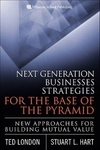Next Generation Business Strategies at the Base of the Pyramid
Published in 2011, this book collects together some of the newest thinking from top academics on doing business in emerging markets.
Previous thinking was that business can make a fortune at the base of the economic pyramid in a way that benefits the poor. Newer strategies propose that business needs to focus on creating opportunities with the poor as partners. So, rather than asking how to sell products to the poor, companies are shifting to ask how they, in partnership with the poor, can address problems of the poor through viable business opportunities.
Authors Stuart Hart and Ted London have had their hands in several groundbreaking articles and books in this field over the last decade. Here they attempt to expand on these new strategies, addressing some of the key challenges that companies have encountered while stepping out into this growing sector. The book includes input from a range of contributors, many with practical experience, such as Erik Simanis, Cornell University, who led a field team in a Kenyan slum on behalf of the company S.C. Johnson. They have gained much from their efforts and have a range of key new insights to share.
Throughout the book the authors make a strong case for the need for partnerships to help take base of the pyramid initiatives to scale. In particular, chapter 7, written by Allen Hammond, Ashoka Foundation, presents the idea that partnerships between a multinational company and a local NGO with on-the-ground experience and connections is a key way of taking this work forward. He gives examples of companies going beyond traditional philanthropy and engaging in partnerships of an in-depth nature to tackle some of the key challenges at the base of the pyramid.
A number of new ideas are presented such as the growing body of green technology initiatives, many of which have applications at the base of the pyramid. Indeed many are being birthed amongst the poor, with potential advantages that could be transferred to developed countries.
Chapter 5 underlines the need to engage in the stories of the poor themselves. The author takes a number of individual’s stories and analyses their situation to draw out implications for base of the pyramid thinking.
The authors utilise a whole host of example initiatives to support their arguments. Some of the most eye-catching of these are listed below.
This book is a critical resource for any in the private, public or non-profit sectors involved in business at the base of the pyramid.
Further information
- Next Generation Business Strategies at the Base of the Pyramid Strategies (official book website)
- Life Spring Hospitals, India
- Arvind Eye Hospitals, India
- Honey Care Africa, Kenya
- Ecotact's Ikotoilets, Kenya


